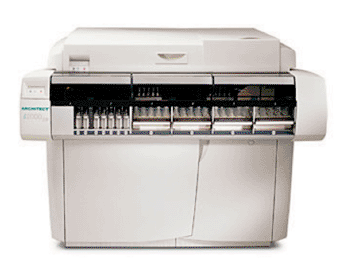Prognostic Performance of High-Sensitivity Cardiac Troponin Assay Evaluated
By LabMedica International staff writers
Posted on 28 Jan 2014
Cardiac troponin is the preferred biomarker for diagnosis of acute myocardial infarction (MI) and is useful for risk stratification of patients with acute coronary syndrome (ACS) and stable ischemic heart disease.Posted on 28 Jan 2014
High-sensitivity assays for cardiac troponin enable more precise measurement of very low concentrations and improved diagnostic accuracy, but the prognostic value of these measurements, particularly at low concentrations, is less well defined.

Image: the ARCHITECT clinical chemistry analyzer (Photo courtesy of Abbott).
Scientists at Brigham and Women's Hospital (Boston, MA, USA) evaluated the prognostic performance of a new high-sensitivity cardiac troponin I (hs-cTnI) assay compared with a fourth-generation commercial cardiac-specific isoforms of troponin T (cTnT) assay in 4,695 patients with non-ST-segment elevation acute coronary syndromes (NSTE-ACS) from the Early Glycoprotein IIb/IIIa Inhibition in NSTE-ACS (EARLY-ACS) and the Otamixaban for the Treatment of Patients with NSTE-ACS (SEPIA-ACS1-TIMI) trials. Baseline cardiac troponin was categorized at the 99th percentile reference limit (26 ng/L for hs-cTnI; 10 ng/L for cTnT) and at sex-specific 99th percentiles for hs-cTnI.
The ARCHITECT STAT High Sensitive Troponin-I assay (hs-cTnI, Abbott; Abbott Park, IL, USA) is a two-step, sandwich chemiluminescent magnetic-microparticle immunoassay that uses two mouse monoclonal antibodies recognizing amino acids 41–49 (capture) and 24–40 (detection) on human cTnI, and a limit of detection of 1.5 ng/L. Troponin T was also measured, using the cTnT, fourth generation assay (Roche Diagnostics; Indianapolis, IN, USA), in 4,221 of the 4,695 study participants with hs-cTnI data; and this assay has a limit of detection of 10 ng/L.
All patients at baseline had detectable hs-cTnI compared with 94.5% with detectable cTnT. At 30 days, patients with a baseline hs-cTnI equal to or greater than 26 ng/L had a significantly higher rate of cardiovascular death or MI compared with those with a baseline measurement below the reference limit. The authors concluded that the assay performed well prognostically, identifying patients at significantly higher 30-day risk of cardiovascular death or new MI using the guideline-based 99th percentile decision limit. The results of the study demonstrate a gradient of risk at very low ranges of concentrations, and performs better with respect to prognosis than a current commercial assay. The study was published in the January 2014 issue of the journal Clinical Chemistry.
Related Links:
Brigham and Women's Hospital
Abbott
Roche Diagnostics







 Analyzer.jpg)





